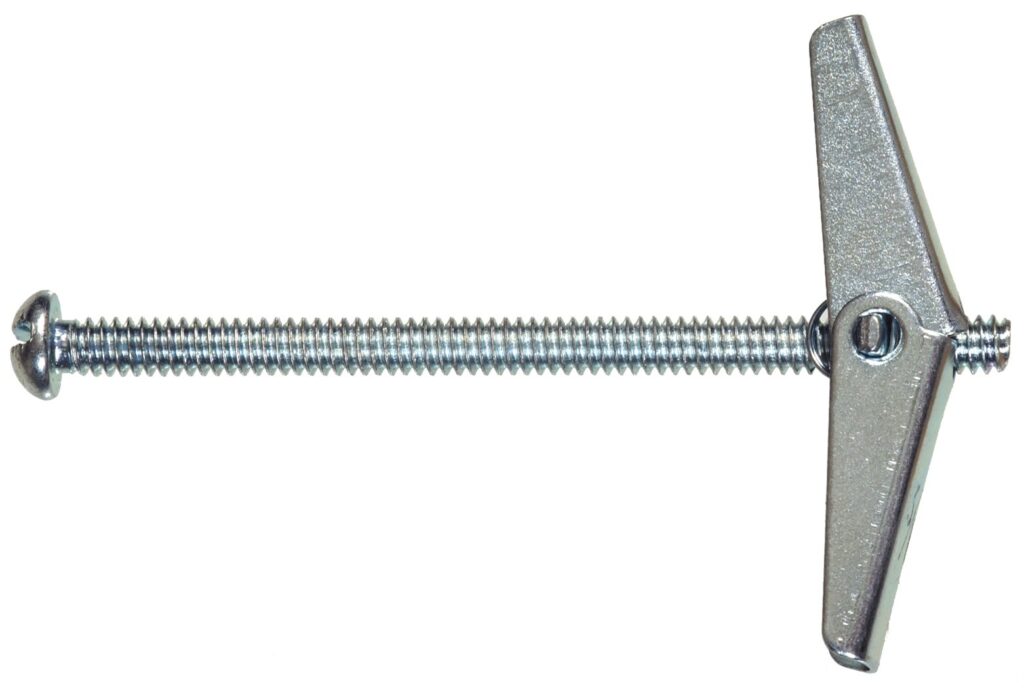In this blog post, we’ll break down the key differences between toggle bolts and molly bolts, helping you decide which one is best for your next project.
When it comes to securing heavy items to walls, the type of anchor you choose can make a significant difference. Two of the most commonly used anchors for drywall and hollow walls are toggle bolts and molly bolts. While both are designed to hold heavier items, they each have unique features that make them better suited for different projects.
What Are Toggle Bolts?
Toggle bolts are a type of anchor that’s used to secure heavy items to hollow walls, like drywall. They consist of a metal bolt and a pair of spring-loaded wings that fold when inserted into a hole in the wall. Once the wings pass through the hole, they spring open behind the wall, providing a wide surface area that helps distribute the weight of the mounted object. This design allows toggle bolts to hold much heavier loads than traditional wall anchors.
Advantages of Toggle Bolts:

- High Weight Capacity
Toggle bolts are known for their impressive weight-holding capacity. The wings distribute the weight evenly across a larger surface area, allowing them to support heavy objects like large mirrors, TVs, shelves, or cabinets. Depending on the size, toggle bolts can support anywhere from 50 lbs to 100 lbs or more. - Wide Range of Applications
Toggle bolts are versatile and can be used in a variety of wall materials, including drywall, plaster, and even hollow concrete block walls. They’re particularly useful for mounting items to walls where there are no studs available. - Reliable Hold
The wings of a toggle bolt create a strong, secure anchor inside the wall, making them less likely to pull out or loosen over time compared to other anchors.
Disadvantages of Toggle Bolts:
- Requires a Larger Hole
Since toggle bolts need to pass through the wall with their wings folded, they require a larger hole to be drilled than other types of anchors. This can be a drawback if you’re working with a wall material you don’t want to damage or if you need to mount something in a tight space. - Difficult to Remove
Once installed, toggle bolts are not as easy to remove as other anchors. If you ever need to take down the mounted object, you’ll likely have to remove the entire bolt and patch up the hole.
What Are Molly Bolts?
Molly bolts, also known as hollow wall anchors, are another popular choice for mounting heavy items on drywall and hollow walls. They consist of a metal sleeve with a screw inside, and once inserted into the wall, they expand behind the drywall, creating a tight grip. Unlike toggle bolts, molly bolts have a more compact design, making them ideal for smaller or more delicate installations.
Advantages of Molly Bolts:

- Smaller Hole Size
Molly bolts require a smaller hole to be drilled than toggle bolts, which makes them a better choice for projects where you want to minimize wall damage. This makes them ideal for lighter-weight items or situations where a large hole is not feasible. - Easier to Remove and Reuse
One of the standout features of molly bolts is their ability to be removed and reused. Once installed, they can be unscrewed without damaging the wall, making them perfect for temporary installations or projects where you might need to adjust the placement later. - Strong Hold in Thin Walls
Molly bolts expand behind the wall to create a strong anchor, making them an excellent choice for drywall and hollow walls. They are ideal for mounting moderately heavy items like light fixtures, small shelves, or picture frames.
Disadvantages of Molly Bolts:
- Lower Weight Capacity
While molly bolts can support a decent amount of weight, they don’t have the same capacity as toggle bolts. Typically, molly bolts are rated to hold between 25-50 lbs, so they may not be the best choice for heavy-duty items like large TVs or cabinets. - More Complicated Installation
Installing molly bolts can be a little more involved than toggle bolts, as they require a precise expansion to grip behind the wall properly. If not installed correctly, they may not provide a secure hold.
Toggle Bolts vs. Molly Bolts: Which Should You Choose?
Both toggle bolts and molly bolts offer strong solutions for mounting items on drywall and hollow walls, but the best choice depends on the specifics of your project.
- Choose Toggle Bolts if:
- You’re mounting heavy items, such as large TVs, bookshelves, or mirrors.
- You need a very strong and secure hold.
- You’re working with a hollow wall material or need to mount to walls where studs are unavailable.
- Choose Molly Bolts if:
- You’re mounting medium-weight items, such as picture frames, light fixtures, or small shelves.
- You want to minimize wall damage with a smaller hole.
- You need an anchor that can be easily removed and reused.
Conclusion
Toggle bolts and molly bolts each have their advantages, and the right one for your project depends on the weight of the item you’re mounting, the material of your wall, and your preference for ease of installation and removal. If you’re mounting something heavy, toggle bolts will likely be your best option, offering a secure hold that won’t let you down. However, for lighter applications where you want a cleaner installation and the ability to reuse anchors, molly bolts are a great choice. Either way, understanding the pros and cons of each anchor type ensures that you can complete your project with confidence and a secure hold.